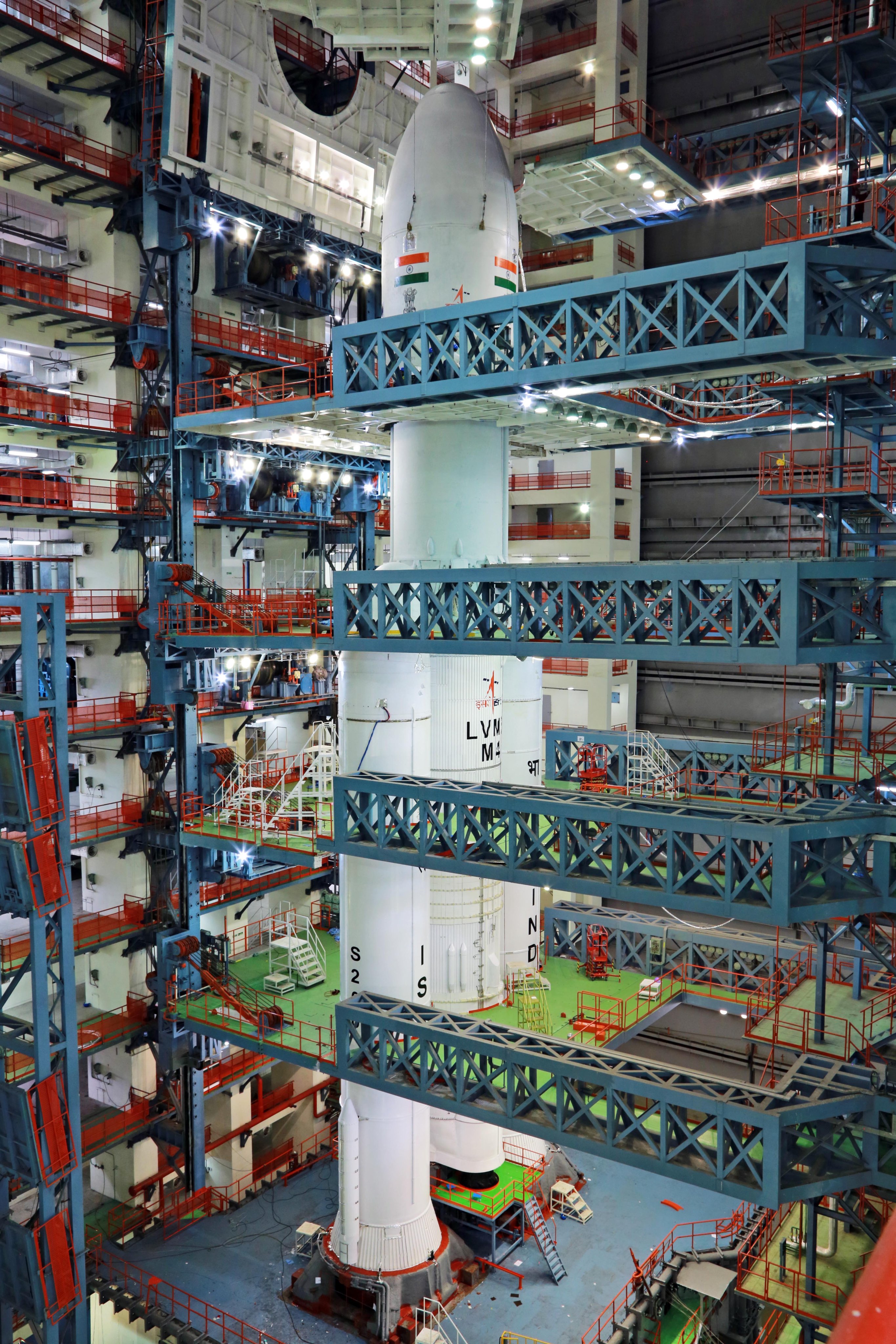Gearing up for its Moon mission, the Indian Space Research organisation today mated the encapsulated assembly containing the Chandrayaan-3 spacecraft with LVM3, its new heavy lift launch vehicle, at Satish Dhawan Space Centre, Sriharikota.
Chandrayaan-3 is a follow-on mission to Chandrayaan-2 to demonstrate end-to-end capability in safe landing and roving on the lunar surface.
"Today, at Satish Dhawan Space Centre, Sriharikota, the encapsulated assembly containing Chandrayaan-3 is mated with LVM3", the Bengaluru-headquartered national space agency tweeted.
ISRO has said the Chandrayaan-3 mission is slated to be launched between July 13 and July 19. "We are aiming to launch it on July 13", an ISRO official said.
The Chandrayaan-3 mission carries scientific instruments to study the thermophysical properties of the lunar regolith, lunar seismicity, lunar surface plasma environment and elemental composition in the vicinity of the landing site.
Lauding India's ambitious space programme, The New York Times has said the country, currently witnessing an "explosive" growth in space-tech start-ups, is set to "transform the planet's connection to the final frontier" and can emerge as a "counterweight" to China.
The article titled 'The Surprising Striver in the World's Space Business' notes that India has become home to at least 140 registered space-tech start-ups, "comprising a local research field that stands to transform the planet's connection to the final frontier."
"The start-ups' growth has been explosive, leaping from five when the pandemic started. And they see a big market to serve," the paper said.
While the scope of these scientific instruments on the lander and the rover would fit in the theme
In March this year, the Chandrayaan-3 spacecraft successfully completed the essential tests that validated its capability to withstand the harsh vibration and acoustic environment that the spacecraft would face during its launch.
These tests were particularly challenging, considering the fact that the Chandrayaan-3 spacecraft, which will be launched by LVM3 (Launch Vehicle Mark-III) (earlier referred to as GSLV Mk III), is a composite of three modules – propulsion, lander and rover.
The propulsion module, which has Spectro-polarimetry of Habitable Planet Earth (SHAPE) payload to study the spectral and polarimetric measurements of Earth from the lunar orbit, will carry the lander and rover configuration till 100 km of the lunar orbit.
of "Science of the Moon", another experimental instrument will study the spectro-polarimetric signatures of the Earth from the lunar orbit, which would fit in the theme of "Science from the Moon", according to ISRO officials.
The lander payloads are: 'Chandra's Surface Thermophysical Experiment' to measure the thermal conductivity and temperature; 'Instrument for Lunar Seismic Activity' for measuring the seismicity around the landing site; and 'Langmuir Probe' to estimate the plasma density and its variations.
A passive Laser Retroreflector Array from US space agency National Aeronautics and Space Administration (NASA) is also accommodated for lunar laser ranging studies.
The rover payloads are: 'Alpha Particle X-ray Spectrometer' and 'Laser Induced Breakdown Spectroscopy' for deriving the elemental composition in the vicinity of the landing site.
The lander will have the capability to soft land at a specified lunar site and deploy the rover which will carry out in-situ chemical analysis of the lunar surface during the course of its mobility.
The main function of the propulsion module is to carry the lander module from launch vehicle injection till final lunar 100 km circular polar orbit and separate it. Apart from this, the propulsion module also has one scientific payload as a value addition, which will be operated post separation of the lander module, it was noted.
Lauding India's ambitious space programme, The New York Times has said the country, currently witnessing an "explosive" growth in space-tech start-ups, is set to "transform the planet's connection to the final frontier" and can emerge as a "counterweight" to China.
"When it launched its first rocket in 1963, India was a poor country pursuing the world's most cutting-edge technology. That projectile, its nose cone wheeled to the launchpad by a bicycle, put a small payload 124 miles above the Earth. India was barely pretending to keep up with the US and the Soviet Union. In today's space race, India has found much surer footing," the leading US newspaper said.
The article titled 'The Surprising Striver in the World's Space Business' notes that India has become home to at least 140 registered space-tech start-ups, "comprising a local research field that stands to transform the planet's connection to the final frontier."
Underscoring that India's "importance as a scientific power" is taking centre stage, the NYT report referred to Prime Minister Narendra Modi's State Visit to Washington last month at the invitation of President Joe Biden and the joint statement issued by the two sides said that said the two leaders "set a course to reach new frontiers across all sectors of space cooperation." In the joint statement, "the leaders called for enhanced commercial collaboration between the US and Indian private sectors in the entire value chain of the space economy and to address export controls and facilitate technology transfer." The NYT report added that both the US and India "see space as an arena in which India can emerge as a counterweight to their mutual rival: China."
"One of India's advantages is geopolitical," the paper said as it added that Russia and China had historically offered lower-cost options for launches.



